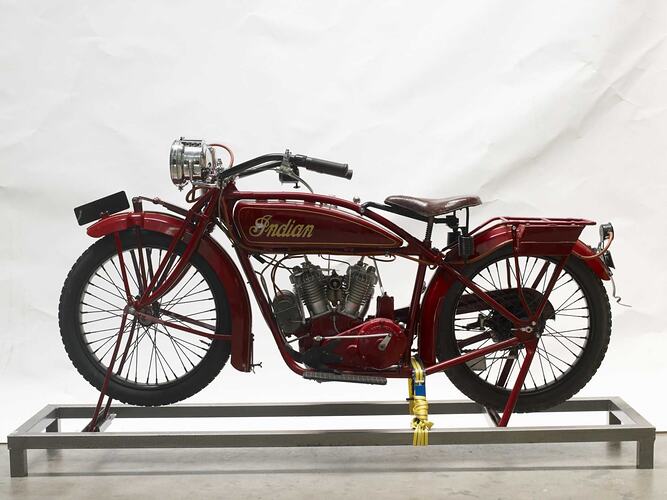'Indian' motor cycles were produced by the Hendee Manufacturing Company at Springfield, Massachusetts, USA in what was at one time the largest motor cycle factory in the world. Founded by George Hendee, the company originally made bicycles before introducing the first 'Indian' motor cycle in 1901, designed by Oscar Hedstrom. Indian motor cycles achieved early racing success before the First World War in America, Britain and Europe and were for many years among the most advanced motor cycles in volume production. Originally built as singles, the company introduced its first V-twin engined bike in 1905, being one of the first manufacturers to produce the type commercially. From 1915, Charlie Gustafson was the company's chief designer. He established the side-valve engine as the most popular American motor cycle powerplant and introduced the famous 7 h.p 998 c.c 'Powerplus' model launched in 1916. The most famous Indian models during the 1920s were the 347 c.c side-valve and overhead-valve single cylinder 'Prince' and the 596 c.c and 746 c.c V-twin 'Scout'. The company also built the larger 998 c.c V-twin 'Chief' and the 1206 c.c V-twin 'Big Chief' and from 1927 produced the 'Indian-4' with a huge 1265 c.c four-cylinder in-line engine. During the 1920s and 1930s Indian was the most popular brand of American motor cycle providing strong competition for Harley Davidson.
During the Second World War the Indian Model 741B was widely used by allied forces. The post-1945 models were less successful and US production ended in 1949. The company went out of business in the 1950s leaving Harley Davidson as the only significant motor cycle manufacturer in the United States. The Hendee Manufacturing Company established their first Australian branch and showrooms at 109-113 Russell Street, Melbourne in 1915. The agency was later taken over by the Rhodes Motor Cycle Company Pty Ltd. The Museum acquired a sectioned 'Powerplus' engine from Rhodes in 1925. Rhodes sponsored several club and competition events and employed works riders such as Vic Barclay who held the Melbourne-Adelaide-Melbourne sidecar record as well as the Melbourne-Sydney solo record. Barclay won the Sidecar Championship of Australia at Cowes in 1928.
In the 1930s Rhodes ceased involvement with motor cycles to concentrate on selling General Motors vehicles as Rhodes Motors, having moved to premises in Elizabeth Street some years earlier. The firm Morgan & Wright at 49 Little La Trobe Street also sold Indian motorcycles in the late 1920s. Four Indian motor cycles with sidecars were the first equipment purchased for the Victoria Police Motor Cycle Patrol when it was established in 1921. It was not until 1946 that solo Victoria Police motor cycles were introduced using a number of ex-Army Harley Davidson machines.
More Information
-
Keywords
-
Localities
-
Authors
-
Article types


